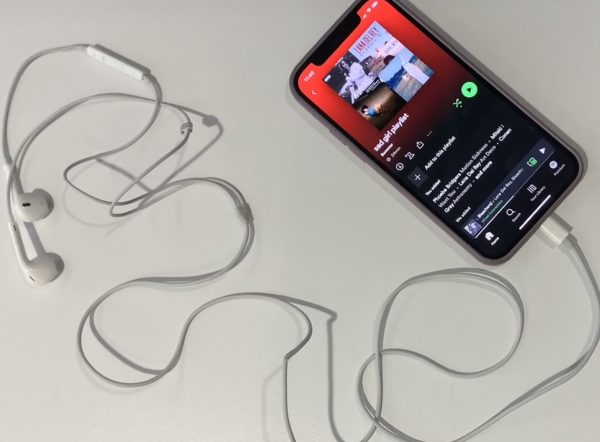Is Distance Learning Comforting?
I think it’s fair to say that education is among the most shattered systems in the COVID-19 pandemic. While we aren’t able to do many of the things we love or see each other every day, there are new factors of emotional security arising from virtual learning. But how can learning in such an isolated manner be good for us? Although teens can’t socialize in-person as much as we used to, physical safety, organization and being home are comforting factors that school is currently offering. Despite being separated from one another, aspects of distance-learning this fall provide comfort in a hectic and unusual time.
This may seem obvious, but when we’re looking at each other through a computer, I can’t give you COVID-19 and you can’t give it to me. That simple fact provides physical safety that is directly related to emotional safety. Without physical health, we cannot thrive in any environment. So, knowing we are safe from a threat like Covid-19 makes us feel secure. Learning from home eliminates the worry of getting the virus from one another, and if that isn’t comforting, I don’t know what is.
When COVID-19 has uprooted so much, anything concrete and organized is unbelievably consoling. One aspect, in particular, is offering new organization and stability in education: the use of Schoology. On Tuesday, Aug. 4, 2020, Superintendent Rob Anderson shared that Schoology would be used this year in grades 4-12 and that this decision was prompted by confusion last spring due to “parents and students having to learn multiple platforms.” Last spring, students and teachers alike were fumbling in the dark to make it through the end of the year. Class materials were spread over various websites and finding the resources for each period became a guessing game, which was not needed in an already difficult time for students. This confusion, along with parents and teachers struggling, led to mass discomfort. This year, however, the mayhem has been reduced and the organization has prevailed. The change to using a uniform platform has added a factor of simplistic certainty in school that was not present last spring or during in-person learning. Opening one tab that contains everything we need for all of our classes is far less stressful than digging for materials last spring or scrambling to get from the Math Wing to the back of the Science Wing in just a few minutes when we were in-person.
Distance-learning offers yet another factor for comfort: our homes. According to Dr. Frank McAndrew, “Home is the place where you feel in control and properly oriented in space and time; it is a predictable and secure place…our physical surroundings play such an important role in creating a sense of meaning and organization in our lives.” Although everyone has a different home situation –and some may be more hectic or difficult than others – we tend to associate our homes with comfort and relaxation. They are our sanctuaries of safeness and now we get to do school from that place of security. That adds a grounding comfort to the school experience that wasn’t there before distance-learning.
Working from home has also been shown to decrease stress and improve productivity. In a two-year study by Stanford, working from home proved to increase concentration and work time. This means students at home can get their work done efficiently. Workers weren’t late, could still work on sick days and worked more of the day, all of which are factors that can reduce chaos for students. Since we can access school from home, there isn’t make-up work-induced stress. So being home reduces certain stressful aspects of in-person learning. And as for productivity, I acknowledge that we built schools to provide the “ultimate” learning facility. However, schools were made before we had access to a virtual workspace and now, if we aren’t able to learn in school, we can certainly learn in comfort from home.
Socialization is indeed important for comfort and teens are especially in need of connection. According to Lumen Learning, “Peer groups are especially important during adolescence…peer groups offer members the opportunity to develop various social skills like empathy, sharing and leadership.” Many would argue that distance-learning is only destructive to students because it makes the social aspect of school much harder. Students are isolated from their peers, and current classes’ function doesn’t allow new friendships or stronger bonds to form. And if these relationships can’t thrive, teens can’t learn essential life skills. But students are not new to a virtual world. For years our generation has been surrounded by technology, practicing for this very situation. We know how to socialize entirely through social media, text, calls, FaceTime and so much more. Our world is getting more and more virtual every day and this recent experience allows students to learn important social skills within the new reality.
Additionally, school has never allowed teens to connect all that much. We have always been rushed off to class, shushed for talking and had to make friends on our own time. While distance-learning may create some barriers for social interaction, teens can interact through other means. We can still connect; we’re great at it. The comfort of each other is still very present.
Right now, it is so easy to look at our new school situation and find it desolate. But there are many aspects to distance-learning that are not only acceptable but good and comforting. We are gaining physical safety, organization and being at home from this rather bleak situation and all of those factors add comfort to our lives, not take it away. Now more than ever, we need optimism to help us see that there is a bright side; we have to look for it.

Halie Leland is a sophomore and a first-year member of The Owl staff. Though she adores sports as an avid skier, volleyball player, and black belt in karate, she has always had a love for writing. By joining The Owl Halie hopes to develop her writing skills further and explore journalism. Her main topics of interest include opinion, news, and feature stories. Although she now enjoys hiking and kombucha, Halie is not a Boulder native. Having grown up in New Mexico gives her an outsider’s perspective on this quirky place we live in, as well as an addiction to green chile. When she’s not working out, serving up aces, or teaching little martial artists, you can find Halie out in nature, reading...





